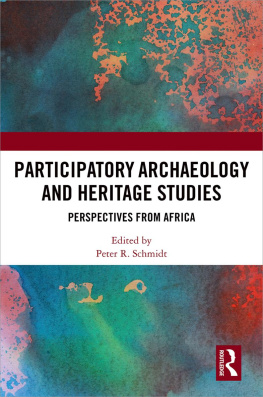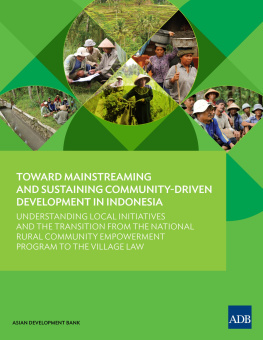
Community-based Heritage in Africa
This volume provides a powerful alternative to the Western paradigms that have governed archaeological inquiry into the past and its meanings in Africa. Community-based Heritage in Africa boldly shifts focus away from top-down community engagements, usually instigated by elite academic and heritage institutions, to examine locally initiated projects. Schmidt explores how and why local research initiatives, which are often motivated by rapid culture change caused by globalization, arose among the Haya people of western Tanzania. In particular, the trauma of HIV/AIDS resulted in the loss of elders who had performed oral traditions and rituals at sacred places, the two most recognized forms of heritage among the Haya as well as distinct alternatives to the authorized heritage discourse favored around the globe.
Examining three local initiatives, Schmidt draws on his experience as an anthropologist invited to collaborate and co-produce with the Haya to provide a poignant rendering of the successes, conflicts, and failures that punctuated their participatory community research efforts. This frank appraisal privileges local voices and focuses attention on the unique and important contributions that such projects can make to the preservation of regional history. Through this blend of personalized narrative and analytical examination, the book provides fresh insights into African archaeology and heritage studies.
Peter R. Schmidt is Professor of Anthropology and African Studies at the University of Florida, USA, as well as Extraordinary Professor of Anthropology and Archaeology at the University of Pretoria, South Africa.
First published 2017
by Routledge
711 Third Avenue, New York, NY 10017
and by Routledge
2 Park Square, Milton Park, Abingdon, Oxon OX14 4RN
Routledge is an imprint of the Taylor & Francis Group, an informa business
2017 Taylor and Francis
The right of Peter Schmidt to be identified as author of this work has been asserted by him/her in accordance with sections 77 and 78 of the Copyright, Designs and Patents Act 1988.
All rights reserved. No part of this book may be reprinted or reproduced or utilised in any form or by any electronic, mechanical, or other means, now known or hereafter invented, including photocopying and recording, or in any information storage or retrieval system, without permission in writing from the publishers.
Trademark notice: Product or corporate names may be trademarks or registered trademarks, and are used only for identification and explanation without intent to infringe.
British Library Cataloguing-in-Publication Data
A catalogue record for this book is available from the British Library
Library of Congress Cataloging-in-Publication Data
Names: Schmidt, Peter R. (Peter Ridgway), 1942 author.
Title: Community-based heritage in Africa : preserving a continent, village
by village / Peter R. Schmidt.
Description: New York : Routledge, 2017. | Includes bibliographical
references and index.
Identifiers: LCCN 2016044696 | ISBN 9781611329537 (hardback : alk.
paper) | ISBN 9781611329520 (pbk. : alk. paper)
Subjects: LCSH: Community archaeologyTanzaniaRugomora Katuruka
Site. | Cultural propertyProtectionTanzaniaRugomora Katuruka Site. |
Haya (African people)Tanzania. | EthnologyTanzania. | Rugomora
Katuruka Site (Tanzania)
Classification: LCC CC77.C66 .S36 2017 | DDC 930.10967827dc23
LC record available at https://lccn.loc.gov/2016044696
ISBN: 978-1-61132-953-7 (hbk)
ISBN: 978-1-61132-952-0 (pbk)
ISBN: 978-1-315-27005-0 (ebk)
Typeset in Bembo
by Apex CoVantage, LLC
This book is dedicated to the villagers of Katuruka and the members of the KPCA, particularly to the memory of the KPCA founder, Benjamin Shegesha: visionary, heritage expert, and friend.
I am writing this in my home study in Balamaga village, several kilometers outside the administrative headquarters of the Kagera Regional government in Bukoba, a now quickly growing urban community. My village setting, overlooking Lake Victoria, captures the ambiance of rural living while it also affords access to other amenities. I am only minutes from three of the primary heritage sites I discuss in this book. I continue periodic work with each of these communities, mutually seeking ways that they can sustain and carry forth the work that they initiated over the last six to seven years. My presence at this time is partly linked to a plan to construct a gateway heritage museum for Kagera Region, an effort that involves a variety of local people as well as foreign academics. Our goal is to feature aspects of the tangible and intangible heritage of Kagera, with the museum leading visitors to explore heritage locales like those featured here. Local politics have thus far impeded final approval of the museum site, planned to incorporate ruins of the German colonial presence on the Lake Victoria waterfront. Patience, the by-word of any undertaking in this part of the world, again comes into play as we wait to launch the next step in linking the gateway museum to the heritage sites discussed here, helping to make them sustainable in the future.
This book is dedicated to the memory of Benjamin Shegesha and Mukama Petro Nyarubamba, who shared a common vision from very different perspectives. They helped community archaeology and heritage take on new meaning and importance in East Africa.
Busimbe-Balamaga, Bukoba
There are many people who were key participants in the performance of the Katuruka, Kanazi, and other heritage initiatives. I can name only a few here, recognizing that many in Katuruka village and its neighboring villages contributed their knowledge and time. The Katuruka heritage committee takes center stage along with several key government and business personalities. Benjamin Shegesha and Daniel Rugomora were the leaders in this initiative. They held the vision and were prepared to devote time, effort, and, in Daniels case, land to the effort. Others who quickly recognized the vision and supported it were Ma Esther Karumuna and Samson Kamukuru.by the particularly cooperative attitude of Robert and Jacob Tibagolorwa who graciously allowed the committee to use a small part of their land for expanded on-site exhibits of ancient iron smelting furnaces during 2011 archaeological inquiries. Philiteo Karumuna was extremely helpful in securing rights to relocate the village road 5 meters into a family-owned farm over a 40-meter passage in order to convert the old road to an exhibit area for ancient iron smelting furnaces. We are also grateful for the assistance provided by Felix Bwehamba (deceased), Eudes Bambanza, Zuriat Mohamed, Leviriani Bambanza (deceased), Christian Matabu (deceased), Earnestina John, Faustin Kamaleki, Benezeti Majenge, Nestori Kato (deceased), Gabriel Kahanga, Claudia Cyprian, and scores of others from Katuruka and Kanyangereko-Nkimbo who provided oral testimonies and shared their knowledge about sacred sites.
Charles Mafwimbo, the Kagera Regional officer responsible for development, has been an invaluable supporter. His encouragement and constant engagement have been central in keeping regional and district authorities appraised about progress and problems. His personal interest has been an inspiration to me and to the committee, with his multiple appearances and representations on site and in government offices. He has been a guardian angel in so many ways. Several members of the business community have been invaluable for their counsel and advice, among them Jay Jethro and Hussein Shabbir Kalfan, not only gracious hosts to visitors associated with the project but wise and informed advisors familiar with the local business culture. Mary Kalikawe of Kiroyera Tours has been an important ally and helpful friend while helping to engage the participation of King Petro Nyarubamba of Kihanja Kingdom at Kanazi. Father David of Kolping Center, I. Rwezahura, and Godwin Rwezahura of the Evangelical Lutheran Church in Tanzania (ELCT) have both provided gracious assistance to the project, along with Lillian Stanley who has performed remarkably as a typist for hundreds of manuscripts. The project owes a special and emphatic thanks to Gelasius Kamanzi, friend, teacher, author, and advisor. Mr. Kamanzi is an extraordinarily talented 80-something student of Haya history who has devoted months of effort to various causes, including the translation of important Haya documents and helping to supervise part of the Kanazi Palace restoration.









